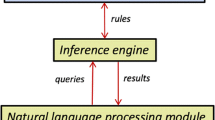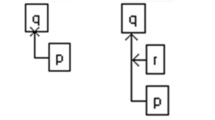Abstract
We present a computational model of dialectical argumentation that could serve as a basis for legal reasoning. The legal domain is an instance of a domain in which knowledge is incomplete, uncertain, and inconsistent. Argumentation is well suited for reasoning in such weak theory domains. We model argument both as information structure, i.e., argument units connecting claims with supporting data, and as dialectical process, i.e., an alternating series of moves by opposing sides. Our model includes burden of proof as a key element, indicating what level of support must be achieved by one side to win the argument. Burden of proof acts as move filter, turntaking mechanism, and termination criterion, eventually determining the winner of an argument. Our model has been implemented in a computer program. We demonstrate the model by considering program output for two examples previously discussed in the artificial intelligence and legal reasoning literature.
Similar content being viewed by others
References
Ashley, K. D. (1990) Modeling Legal Argument: Reasoning with Cases and Hypotheticals. Cambridge, MA: MIT Press, 93–102.
Barth, E. M. and Krabbe, E.C.W. (1982) From Axiom to Dialog: A Philosophical Study of Logics and Argumentation. Berlin, NY Walter de Gruyter.
Branting, K. L. (1991) Reasoning with portions of precedents. Proceedings of the Third International Conference on Artificial Intelligence and Law (ICAIL-91), 145–154.
Freeley, A. (1990) Argumentation and Debate: Critical Thinking for Reasoned Decision Making (7th ed.). Belmont, CA: Wadsworth Publishing Company.
Freeman, K. (1993) Toward Formalizing Dialectical Argumentation. PhD Thesis, Department of Computer and Information Science, University of Oregon.
Ginsberg, M. L. ed. (1987) Readings in Nonmonotonic Reasoning, Los Altos, CA, Morgan Kaufmann.
Gardner, A. (1987) An Artificial Intelligence Approach to Legal Reasoning. MIT Press: Cambridge, MA, 1987.
Gordon, T. F (1993) The pleadings game: formalizing procedural justice. Proceedings of the Fourth International Conference on Artificial Intelligence and Law (ICAIL-93), 10–19.
Hage, J. C. Leenes, R. and Lodder, A. (1994) Hard cases: a precedural approach. Artificial Intelligence and Law, 2, 113–167.
Hage, J. C. (1995) Teleological reasoning in reason-based logic, Proceedings of the Fifth International Conference on Artificial Intelligence and Law (ICAIIT95), 11–20.
Horner, W. (1988) Rhetoric in the classical tradition. St. Martins Press: New York, NY.
Kuhn, D. (1991) The skills of Argument. Cambridge University Press: Cambridge. UK.
Loui, R. P., Norman, J., Olson, J. and Merrill, A. (1993) A design for reasoning with policies, precedents, and rationales. Proceedings of the Fourth International Conference on Artificial Intelligence and Law (ICAIL-93), 202–211.
Marshall, C. (1989) Representing the structure of legal argument. Proceedings of the Second International Conference on Artificial Intelligence and Law (ICAIL-89), 121–127.
Pearl, J. (1987). Embracing causality in formal reasoning. Proceedings of AAAI-87, 369–373.
Pearl, J. (1988) Probabilistic Reasoning in Intelligent Systems: Networks of Plausible Inference. Morgan Kaufmann: San Mateo, CA.
Pollock, J. (1987). Defeasible reasoning. Cognitive Science 11, 481–518.
Pollock, J. (1991). A theory of defeasible reasoning. International Journal of Intelligent Systems 6, 33–54.
Pollock, J. (1992). How to reason defeasibly. Artificial Intelligence 57, 1–42.
Pollock, J. (1994). Justification and defeat. Artificial Intelligence 67, 377–407.
Poole, D. L. (1985), On the comparison of theories: Preferring the most specific explanation, Proceedings IJCAI-85, 144–147.
Polya, G. (1968). Mathematics and plausible reasoning (2nd ed.) (v. II). Princeton, NJ: Princeton University Press.
Porter, B., Bareiss, R., and Holte, R. (1990). Concept learning and heuristic classification in weak theory domains. Artificial Intelligence 45, 229–263.
Prakken, H. (1991) A tool in modelling disagreement in law: preferring the most specific argument. Proceedings of the Third International Conference on Artificial Intelligence and Law (ICAIL-91), 165–174.
Prakken, H. (1993) A logical framework for modelling legal argument. Proceedings of the Fourth International Conference on Artificial Intelligence and Law (ICAIL-93), 1–9.
Prakken, H. and Sartor, G. (1995) On the relation between legal language and legal argument: assumptions, applicability, and dynamic priorities. Proceedings of the Fifth International Conf. on Artificial Intelligence and Law (ICAIL-95), 1–11.
Rescher, N. (1976). Plausible Reasoning. Assen/Amsterdam, The Netherlands: Van Gorcum.
Rescher, N. (1977). Dialectics: A controversy-oriented approach to the theory of knowledge. Albany, NY. State University of New York Press.
Rissland, E. L. (1985) Argument moves and hypotheticals. In C. Walter (ed.) Computing Power and Legal Reasoning, St. Paul, MN: West Publishing.
Sartor, G. (1993) A simple computational model for nonmonotonic and adversarial legal reasoning. Proceedings of the Fourth International Conference on Artificial Intelligence and Law (ICAIL - 93), 192–201.
Skalak, D. B. and Rissland, E. L. (1991), Argument moves in a rule-guided domain. Proceedings of the Third International Conference on Artificial Intelligence and Law (ICAIL-91), 1–11.
Toulmin, S. (1958). The uses of argument. Cambridge, UK: Cambridge University Press, 1958.
Author information
Authors and Affiliations
Rights and permissions
About this article
Cite this article
Freeman, K., Farley, A.M. A model of argumentation and its application to legal reasoning. Artif Intell Law 4, 163–197 (1996). https://doi.org/10.1007/BF00118492
Issue Date:
DOI: https://doi.org/10.1007/BF00118492




